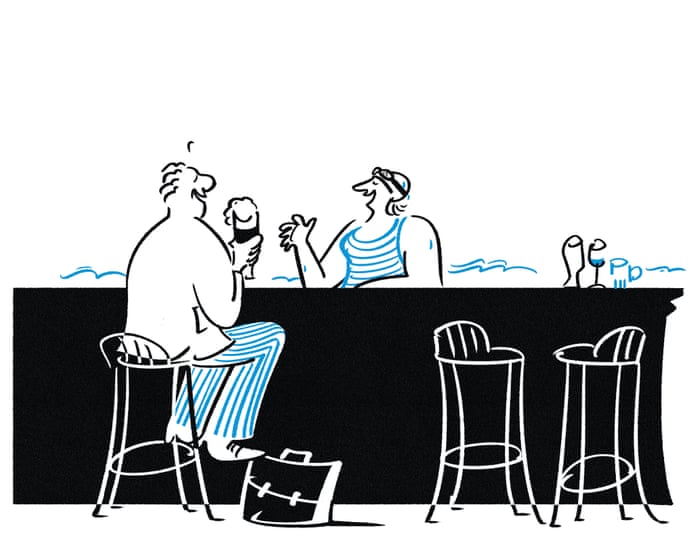Iceland: A Nation of Swimmers
Iceland is home to around 160 swimming pools. With a population just over 400,000, that works out to roughly one pool for every 2,500 people. This is fitting, since swimming is deeply rooted in the national culture. This tradition is relatively recent: swimming lessons became compulsory for schoolchildren in 1940, following a series of drownings due to poor swimming skills.
Filmmaker Jón Karl Helgason, who directed the 2022 documentary Sundlaugasögur (Swimming Pool Stories), says, “We grew up in the swimming pool. It’s everyone’s playground. You start by going with your parents, and later you bring your girlfriend or boyfriend.”
Helgason swims almost daily in Reykjavík, paying just 4,000 krona (about £25) per year for unlimited access to his favorite public pool—one of 18 in the capital. Most pools are outdoors and heated geothermally, making swimming a more affordable activity than in countries that rely on artificial heating.
Beyond the physical benefits, swimming also offers mental and social rewards. “You meet all kinds of people, from farmers to politicians,” Helgason notes. Many pools feature “hot pots” (hot tubs), inspired by Iceland’s natural hot springs, as well as cold plunge pools and saunas. And one rule is universal: no phones allowed.
There’s even a campaign to have Iceland’s pools recognized as UNESCO cultural heritage. Helgason sums it up: “You Brits go to the pub—we go to the swimming pool.”
Ukraine: The Art of Fermentation
While sauerkraut, pickles, and kefir have become trendy across Europe, fermented foods have long been a staple in Ukraine. Felicity Spector, a London-based author and volunteer with Bake for Ukraine—a nonprofit that runs a mobile bakery in Mykolaiv—has been struck by the country’s dedication to preserving food.
Since her first visit in the summer of 2022, Spector has observed how common it is for Ukrainians, especially those with access to land, to grow and preserve their own fruits and vegetables for the winter. This practice dates back to Soviet times, when people couldn’t rely on store supplies, and continues today amid power outages and conflict.
Spector learned lacto-fermentation techniques from Ukrainian chef Olia Hercules—a method that uses salt and brine instead of vinegar. Vegetables are salted, weighted down or covered in brine, left to ferment for about 10 days, then sealed and stored for up to a year. It’s not unusual to find rows of preserved jars in basements, cupboards, or even under beds.
While not always a conscious health choice, fermented foods offer clear benefits. They contain probiotics that support gut health, reduce inflammation, and restore natural balance. Ukrainians enjoy a variety of fermented dairy products like kefir and ryazhenka (a baked fermented milk with a caramelized flavor), as well as sourdough bread—all traditional foods with centuries-old roots.
As Spector notes, in Ukraine, kefir isn’t an expensive health fad—it’s everyday fare, often sold in large jugs or even repurposed Coca-Cola bottles at the market.Beyond the usual methods, many fruits are fermented to help bridge the lean winter months. Spector has just gotten a container of juicy, tangy plums, noting, “There’s really nothing that hasn’t been preserved in a jar.”
‘Smaller, more frequent meals keep energy levels and focus steady’
Switzerland: eating five times a day
Instead of grazing all day, the Swiss traditionally stick to five scheduled meals, as regular as their trains. In German-speaking regions, these are called zmorge (breakfast), znüni (mid-morning snack), zmittag (lunch), zvieri (afternoon snack), and znacht (dinner). Sandra Mikhail, a dietitian in Zurich, says the extra meals are common in French-speaking areas too: “Most Swiss people I work with have about four meals: breakfast, lunch, an afternoon snack, and dinner.”
The morning snack often includes spelt bread, fruit, or a gipfeli (croissant), while the afternoon snack is more substantial, perhaps with dips or bircher muesli. Lunch is the largest meal of the day, Mikhail explains, “to align with our circadian rhythms and digestion—our metabolism and insulin sensitivity are generally stronger earlier in the day. A lighter dinner can improve sleep quality and reduce overnight digestive discomfort, and having smaller, more frequent meals helps maintain steady energy and focus. It also aids digestion, as smaller meals are easier for the body to process, reducing discomfort and bloating. By regulating appetite and preventing overeating, frequent meals support better appetite control, can help with weight management, and assist in muscle maintenance and growth.”
However, Mikhail adds, “it’s important to recognize that everyone has unique needs. It’s about listening to your own hunger and fullness cues rather than strictly following a set number of meals.”
‘A brisk walk and strong wind shift our mood’
The Netherlands: embracing the breeze
Living in a windy place means making the most of the breeze, something the Dutch have done for centuries, says Arie Boomsma, a gym chain owner and author of the “10,000 Steps Book.” He discusses the concept of uitwaaien, which “the Dutch use when they go outside to clear their minds of everyday stress.” Boomsma explains, “It comes from waaien, ‘to be moved by the wind,’ combined with uit, ‘going outward or letting something go.’ In the 17th century, it described smoke or dust being blown away, and by the 19th and 20th centuries, it took on its modern meaning: going out to let the wind clear your head.”
He clarifies that uitwaaien shouldn’t be confused with niksen, the art of doing nothing. “Niksen is a passive way of relaxing, while uitwaaien is active. You have to move. A brisk walk and a strong wind can really change our mood and shift our perspective.”
‘Eating together shows a desire to reconnect’
Denmark: communal dining
Danes are reviving the tradition of fællesspisning, or communal dining, according to Judith Kyst. As director of Madkulturen, an organization within the ministry of food and agriculture that tracks the nation’s eating habits, Kyst is well-versed in Danish dining customs. She notes a long history of social dining rooted in the folkekøkken (soup kitchen) tradition from the 19th-century labor movement, which provided affordable meals for workers. This practice involves healthy food, often prepared collectively and eaten at long tables by strangers in venues ranging from village halls to daycare centers. The renewed interest in this tradition reflects a need to “be together around the meal,” Kyst says, as a “counter-reaction to individualism, loneliness, and screen time,” showing a “desire to reconnect.””So what can you expect to eat? ‘To keep it cheap you often get chickpea curries and lots of greens,’ Kyst says. This affordability makes the meals accessible and inherently healthy. ‘When families join these meals, children eat more fruits and vegetables. People say that eating together leads to healthier eating habits.’ This connects with another Danish concept, ‘madglæde,’ which means taking joy in food.
‘Rest is Embraced’
Spain: The Siesta
In a world where digital distractions seem to steal our rest, a different approach to sleep is appealing. Consider the traditional Spanish siesta, or post-lunch nap.
‘Naps can benefit sleep health if done correctly,’ says Polly Revaliente, co-founder of The Sleep Project in Madrid. ‘Short naps in the early afternoon, lasting 20 to 30 minutes, can enhance alertness, memory, and mood.’ However, timing is crucial: ‘Naps that are too long or taken too late in the day can disrupt nighttime sleep. Those who are prone to insomnia should either avoid naps or keep them brief and consistent.’
Does the entire country still pause for a nap? ‘The siesta is part of our cultural image, but it’s no longer a regular part of most people’s workday,’ Revaliente explains. In summer, workers finish early due to the heat, but for most of the year, Spanish work hours start early and end late. ‘With late dinners and evening news broadcasts at 10 p.m. or later, Spaniards tend to go to bed later than Britons but wake up at similar times, which can result in a sleep deficit,’ Revaliente notes.
Nevertheless, the culture of relaxation is deeply rooted. ‘Rest is embraced, especially on weekends, holidays, and by the older generation. What Spain arguably preserves best is the idea that rest isn’t lazy—it’s an essential part of life.’
‘Growing up in West Berlin in the 60s, the main warm meal was always at midday.’
Germany: Light Food in the Evening
Traditional German dishes like potatoes and meat might not sound easy on the digestive system, but Abendbrot (evening bread) is designed to be lighter than the more substantial midday meal, aiding digestion and sleep.
‘I grew up in West Berlin in the 60s. The main warm meal was always at midday,’ says Ursula Heinzelmann, author of ‘Beyond Bratwurst: A History of Food in Germany.’ ‘Typically, dinner would consist of sliced bread with cheese, ham, or sausage. In our family, there was always something fresh: cucumber, tomatoes, or radishes—whatever was in season.’ The type of bread was also quite specific. ‘Here in Berlin, it would be rye sourdough or Graubrot, a mix of wheat and rye. White bread was a rare treat, usually reserved for Sundays.’
After Sunday lunch, Heinzelmann’s family would take a long walk in the forest and exercise on the ‘Trimm-dich-pfad’ (trim-yourself path), named after the 1970s ‘Trim yourself’ health campaign. ‘You’d follow signs and do exercises to get in shape. I haven’t seen one lately, but I’ve heard they’re making a comeback.’
Heinzelmann confirms that Abendbrot is still common, though it sometimes shifts…”When it comes to lunchtime, things are evolving. In families where both parents work, the main warm meal might shift to the evening. There’s also a growing emphasis on fresh ingredients alongside the bread. “There’s a lot of awareness, especially among younger people, about which ingredients are healthy and which aren’t,” Heinzelmann notes.
Would you eat bread in the evening at a friend’s place or a restaurant? “Not me! It’s really more of a home tradition.”
‘It was once on the fringe; now it’s mainstream’
France: Sophrology
You’re familiar with yoga, meditation, and mindfulness for stress relief; in France, they rely on sophrology. Julia Bache, a British doctor who has lived in Paris for three decades, first encountered it while working in French clinics. She explains that it includes “physical and mental exercises like controlled breathing, muscle relaxation, gentle movements, visualization, meditation, and mindfulness to balance the body and mind,” and is used for everything from stress and sleep issues to pain and tinnitus. Bache says that while sophrology was once seen as “a bit out there, now it’s more accepted as mainstream,” with growing use in schools and coverage by health insurance.
Sophrologist Sophie McGrath, who grew up in Paris but now resides in London, discovered the method as a stressed teen through her grandmother, who attended group sessions in a village hall. “It changed my life,” she shares. “It took some time before I started practicing daily and really got into it, then I decided to study it, and here I am.”
In France, McGrath notes, “it’s quite common to see a sophrologist… it’s much more prevalent than in the UK.” The practice was developed in the 1960s by Colombian neuropsychiatrist Alfonso Caycedo, who worked in France, Spain, and Switzerland. “It just never got translated into English,” says McGrath, who works at BeSophro in the UK, offering one-on-one sessions to help clients prepare for childbirth, job interviews, or exams by “working on the somatic part of the nervous system” that controls voluntary actions. She sees many French expats but adds that the practice is gaining recognition. “It really can speak to everyone.”
‘We’ve just sat down for a long meal; now it’s time to get out and move’
Italy: A Postprandial Stroll
The Italian tradition of la passeggiata—a walk after a meal—was originally about socializing and being seen in the neighborhood in the early evening. It’s also an excellent way to help digest a hearty pasta dish.
“The idea is: we’ve just enjoyed a long meal with friends or family, so now it’s time to go out, move around, and get some fresh air,” says Dr. Federica Amati, who spent her early years in Rome but now lives in the UK, where she is the head nutritionist for the personalized nutrition app Zoe and a nutrition lead at Imperial College London. This custom remains a social norm in Italy, especially in summer, Amati explains: “Stores close between 1 pm and 4 pm, then reopen, to fit with this habit.”
Besides being a chance to socialize, which benefits mental health, it aids digestion “because gravity helps our guts move food through our bodies.” Walking assists the lymphatic system in distributing nutrients and offers metabolic advantages. “Within half an hour of eating, we start absorbing sugars and fats in the small intestine, which are good energy sources. If you take a little passeggiata, you’re making the most of that energy in your muscles.”
Even though she hasn’t lived in Italy for 30 years, “it’s something that has stuck with me,” Amati says. She loves going for a walk after dinner, often with her dog, and always does so when in Rome.
‘It’s a blanket rule for a…Almost all children in Sweden grow up with the tradition of “lördagsgodis,” which means sweets only on Saturdays. This custom was introduced by the government in the 1950s to help prevent tooth decay among kids. Linnea Dunne, author of Lagom: The Swedish Art of Balanced Living, explains that it’s a deeply rooted practice. “There are very few Swedish children who aren’t familiar with it,” she says. “It’s an institution that everyone follows.”
Dunne, who now lives in Dublin but grew up near Stockholm, remembers the weekly ritual of picking out mixed sweets, a tradition that continues today. “When I visit back home, I see my brother’s children still doing it, and his oldest is 13. It’s a universal rule for nearly all kids—sweets are for Saturdays only, and that’s it. You wouldn’t have other sugary treats like cakes on weekdays either.”
She acknowledges that this might seem strict or even a bit dull, but it aligns with the Swedish concept of “lagom,” or moderation. “It reflects a lifestyle focused on balance. We know eating sweets every day isn’t good, so we save it for Saturdays, and that’s what everyone does.”
As for her own children, Dunne says, “We followed it when they were younger. Now that they’re 11 and 13, it’s not as strict. But if they want sweets and it’s a Saturday, they’ll use their Swedish heritage as an excuse.”
Frequently Asked Questions
Of course Here is a list of FAQs about European health habits framed around the idea of You Brits head to the pub while we head to the swimming pool
General Beginner Questions
1 What does European health habits worth embracing even mean
It refers to common everyday lifestyle choices in many European countries that contribute to better physical and mental wellbeing which people in other parts of the world could learn from
2 Whats a simple example of one of these habits
A great example is the Mediterranean tradition of a leisurely afternoon walk known as a passeggiata in Italy Its not about intense exercise but about moving your body socializing and decompressing
3 Why is going to a swimming pool considered a health habit
Regular swimming is a fantastic fullbody lowimpact exercise that improves cardiovascular health builds muscle strength and is great for mental relaxation
4 Arent these habits just about diet like the Mediterranean diet
While diet is a big part of it these habits are also about a slower pace of life prioritizing social connection and integrating enjoyable physical activity into your daily routine not just what you eat
Benefits Advantages
5 What are the main benefits of adopting these habits
The benefits include reduced stress better heart health stronger social bonds improved fitness and a generally more balanced and enjoyable approach to life
6 How does the pub culture in the UK fit into health
When done in moderation the British pub culture emphasizes community and social connection which is a crucial pillar of mental health Its about the conversation and camaraderie as much as the drink
7 Is the siesta a real health habit or just a nap
A true siesta is more than a nap its a structured break in the middle of the day to escape the heat enjoy a substantial meal with family and rest This can lower stress and improve afternoon productivity
Common Problems Challenges
8 I have a busy schedule How can I possibly fit in a long leisurely lunch or a daily swim
You dont have to adopt it perfectly Start small Try a 15minute digital detox walk after lunch instead of scrolling on your phone or schedule one longer devicefree meal with family or friends on the weekend




